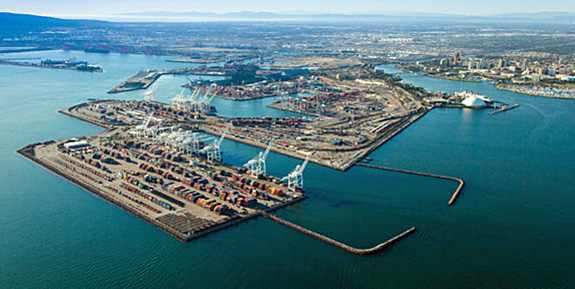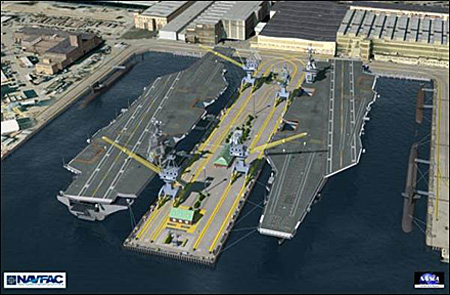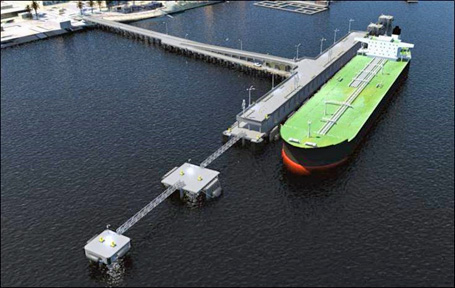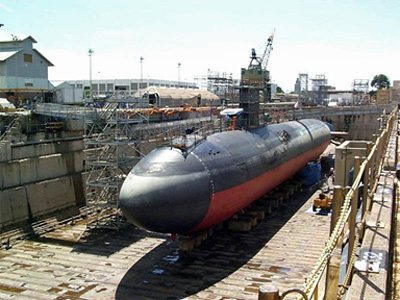Overview
Within This Page
Approximately 40% of the population lives near the coast. The percentage of people living near any body of water is even greater when you consider inland waterways such as lakes and rivers. Throughout history the fine line between land and water has played a significant role in transportation, commerce, recreation, and even survival. This is where the interface between the land and water becomes important and is what is known as the Waterfront.
Nearly every town or city bordering a body of water has an industrial, commercial, recreational, or residential district called the Waterfront. And the structures along it provide the critical link between terrestrial humans and open waters. This infrastructure is what makes up the backbone of Waterfront Facilities, also known as Marine Facilities, and more generally Ports and Harbors.

Waterfront includes an array of structures and components related to the berthing, mooring, operations, and maintenance of ships and other vessels. It also includes, coastal and shore protection structures that help define and protect ports and harbors. Common waterfront elements are piers, wharves, bulkheads, dry docks, breakwaters, boat ramps, and marinas. Waterfront structures have multiple uses ranging from industrial, to commercial, to military, and recreational.
This building type on the WBDG is dedicated to waterfront (marine) facilities, ports, harbors, coastal structures, and other waterfront elements and components.
Classification
There are many types of waterfront facilities and structures with varying uses and functions.
- Ports and Harbors
- Piers and Wharves
- Dry Docks
- Bulkheads, Quay walls
- Small Craft Berthing, Marinas
- Breakwaters, Jetties
- Auxiliary Structures, Components, Equipment
Building Attributes
Waterfront facilities, ports, harbors, and marine structures are not a typical type of building, but are significant in their own right to commercial, industrial, transportation, military, and recreational activities. Typical port and harbor waterfront facilities include marine terminals (cargo, container, roll on/roll off, dry bulk, liquid bulk, barge), passenger terminals (ferry, passenger/cruise ship), military bases, shipyards, and small craft facilities (commercial, workboats, marinas, recreational). The following are descriptions of various facilities and structures found at ports and make-up the waterfront.
Descriptions
Harbor: A water area that is bounded by natural features or manmade structures or a combination of both. That provides refuge, safe moorings, and protection for vessels during storms or accommodations for such water-to-water or water-to-land activities as resupply, refueling, repairs, or transferring cargo and personnel.
Port: Harbor and/or areas in a harbor with waterfront facilities used to load and unload ships, transfer cargo, or passengers. This includes landside areas adjacent to harbors that support various waterborne activities.

Ports of Los Angeles and Long Beach, CA
Photo Credit: Container News
Dock: General structure or place where a ship or vessel can be moored.
Pier: A structure that projects out from the shore into the water and is oriented either perpendicular to or at an angle with the shore. It may be used on both sides, but sometimes only one.

Pier 5 Norfolk Naval Shipyard, VA
Rendering: Moffat & Nichol
Wharf: A structure similar to a pier, but is oriented approximately parallel to the shore. A marginal wharf is located along the edge of a shore and ships can only be moored at the offshore face. A wharf may also be located away from the shore and connected to the shore by one or more trestles.

Fuel Pier (Wharf), NS Point Loma, CA
Rendering: Moffat & Nichol
Dry Dock: A specialized facility used for the repair of ships where the vessel is removed from the water or placed within a lock and the water is removed leaving the ship in the dry to facilitate repairs.

Submarine in Dry Dock
Photo Credit: U.S. Navy
Bulkhead: A retaining structure along a waterfront that provides a vertical face for mooring vessels.
Quay wall: A structure built parallel to a shoreline similar to a marginal wharf that also serves as a soil-retaining structure.
Small Craft Berthing (Marina): Port facility for berthing small water craft and recreational craft.
Breakwater: A manmade structure that protects a shore area or harbor by breaking up or reducing waves.
Jetty: A waterfront coastal protection structure that extends into a body of water to influence waves, currents, or sedimentation in order to protect a shoreline or channel.
Seawall: A waterfront coastal protection structure built along a portion of a shoreline to prevent erosion and other damage by wave action.
Emerging Issues
Waterfront and coastal environments inherently produce very punishing and dynamic conditions. Resiliency to deterioration, corrosion, wave action, scour, tidal changes, and sea level rise are chief concerns and require evaluation and protection to maintain the integrity and usefulness of waterfront facilities. Some emerging issues and technologies include:
- Service Life Modeling on Marine Concrete
- Corrosion
- Composite Materials
- Impacts of Climate Change and Sea Level Rise
- Seismic Design of Waterfront Structures
Relevant Codes, Standards, and Guidelines
American Society of Civil Engineers (ASCE)
- ASCE 7 Minimum Design Loads for Buildings and Other Structures
- ASCE 24 Flood Resistant Design and Construction
- ASCE 61 Seismic Design of Piers and Wharves
- MOP 50 Planning and Design Guidelines for Small Craft Harbors
- MOP 129 Mooring of Ships to Piers and Wharves
- MOP 130 Waterfront Facilities Inspection and Assessment
International Code Council (ICC)
Department of Defense (DoD0
- Unified Facilities Criteria (UFC)
- UFC 1-200-01 DoD Building Code (General Building Requirements)
- UFC 3-301-01 Structural Engineering
- UFC 4-150-02 Dockside Utilities for Ship Service
- UFC 4-150-06 Military Harbors and Coastal Facilities
- UFC 4-150-07 Maintenance & Operation: Maintenance of Waterfront Facilities
- UFC 4-150-08 Inspection of Mooring Hardware
- UFC 4-151-10 General Criteria for Waterfront Construction
- UFC 4-152-01 Piers and Wharves
- UFC 4-152-07 Small Craft Berthing Facilities
- UFC 4-159-01N Hyperbaric Facilities
- UFC 4-159-03 Moorings
- UFC 4-213-10 Graving Dry Docks
- UFC 4-213-12 Drydocking Facilities Characteristics
- Unified Facilities Guide Specifications (UFGS)
U.S. Army Corps of Engineers (USACE)
Additional Resources
Federal Agencies
- Federal Emergency Management Agency (FEMA)
- Maritime Administration (MARAD)
- National Oceanic and Atmospheric Administration (NOAA)
- Naval Facilities Engineering Command (NAVFAC)
- U.S. Air Force Civil Engineer Center (AFCEC)
- U.S. Army Corps of Engineers (USACE)
- U.S. Geological Survey (USGS)
- USCG Facilitates Design and Construction Center (FDCC)
Organizations / Associations
- American Association of State Highway and Transportation Officials (AASHTO)
- American Society of Civil Engineers (ASCE)
- Coasts, Oceans, Ports, and Rivers Institute (COPRI)
- Oil Companies International Marine Forum (OCIMF)
- World Association for Waterborne Transport Infrastructure (PIANC)
Publications
- ASCE Books and Standards
- ASCE Library
- Design of Marine Facilities: Engineering for Port and Harbor Structures by John W. Gaythwaite. Reston, VA: ASCE Press, 2016.
- Marine Oil Terminal Engineering and Maintenance Standards (MOTEMS), Marine Oil Terminals, California Code of Regulations, Part 2, California Building Code, Chapter 31F, Title 24 by California State Lands Commission. Sacramento, CA: SLC, 2013.
- OCIMF Publications
- PIANC Publications
- Seismic Guidelines for Ports by S. D. Werner. Reston, VA: ASCE-TCEE, 1998.
- Seismic Design Guidelines for Port Structures by PIANC. Exton, PA: A.A. Balkema Publishers, 2001.
- USACE Publications
- Wharf Design Criteria Version 4.0 by Port of Long Beach (POLB). Long Beach, CA: POLB, 2015.
Industry News & Periodicals
Ships
- Haze Gray & Underway
- Jane's Fighting Ships
- MARAD Vessel History Database
- Military Sealift Command (MSC)
- Naval Vessel Register (NVR)
- NOAA Marine Operations—Ships
Tools
- FEMA Flood Map Service Center
- NOAA Sea Level Rise Viewer
- NOAA Tides and Currents
- USACE Sea Level Change Curve Calculator
Training
- ASCE PORTS Conference
- Fleet Mooring Inspection (videos coming soon)
- Inspection of Mooring Chain Using Single & Double Link Go/No Gauges
- Inspection of Mooring Riser Swivel Shackle under Buoy
- Inspection of Chain Joining Link & Anchor Joining Link
- Surface Inspection of Anchor Bolt Shackle and Pear Links
- Surface Inspection of Foam-Filled Buoy








